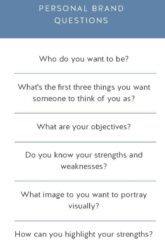Developing Your Personal Brand in the Digital World

Building Your Personal Brand Online
In today’s digital age, building your personal brand online has become essential. Whether you’re an entrepreneur, a professional, or a creative individual, a strong personal brand can open doors, establish credibility, and set you apart from the competition. Let’s dive into a step-by-step guide to help you craft and maintain a standout personal brand.
What Is a Personal Brand?
A personal brand is the perception people have of you based on your online presence, actions, and interactions. It’s essentially your reputation combined with the unique qualities that define you. Think of it as your digital business card, one that tells your story, highlights your expertise, and showcases your values.
Why Is Building a Personal Brand Important?
Building a personal brand online isn’t just for influencers or public figures. Here’s why it matters:
- Professional Opportunities: Employers, clients, and collaborators often search for people online before working with them.
- Credibility and Trust: A well-crafted online presence makes you a trusted voice in your industry.
- Networking: A strong personal brand attracts like-minded individuals and valuable connections.
- Control of Your Narrative: It ensures that what others see about you reflects your true self.
Step 1: Define Your Brand Identity
Before creating your online persona, you need clarity about who you are and what you stand for. Here’s how to define your brand identity:
- Identify Your Strengths and Skills: What are you good at? What makes you unique?
- Clarify Your Values: Your values should resonate through your content and interactions.
- Determine Your Goals: Are you building your brand for career advancement, entrepreneurship, or creative recognition?
- Understand Your Audience: Who do you want to reach, and what do they care about?
Pro Tip: Use a personal mission statement to summarize your brand. For example, “I help young entrepreneurs scale their businesses through actionable advice and mentorship.”
Step 2: Create a Consistent Visual Identity
Your visual identity helps people recognize your brand at a glance. Think of your visuals as your brand’s signature. Here’s what to focus on:
- Profile Picture: Use a professional and approachable headshot across all platforms.
- Color Palette: Choose 2-3 colors that reflect your personality or industry.
- Typography: Stick to a few fonts that look clean and professional.
- Logo or Icon: If applicable, design a simple logo that ties into your niche.
Quick Tip: Tools like Canva or Adobe Express can help you create cohesive visuals easily.
Step 3: Optimize Your Online Profiles
Your social media and professional profiles act as your brand’s storefront. Make them inviting and informative. Here’s a breakdown:
- LinkedIn:
- Use a professional headline that captures your expertise.
- Write a compelling summary highlighting your achievements and goals.
- Update your experience, skills, and certifications.
2.Instagram:
- Craft a bio that reflects your personality or niche.
- Use highlights to showcase your expertise, work, or interests.
3.Twitter/X:
- Keep your bio concise with a focus on what you tweet about.
- Add a link to your website or portfolio.
4.Personal Website:
- If possible, create a website with your name as the domain.
- Include sections like “About Me,” “Portfolio,” and “Contact.”
Pro Tip: Use the same username across all platforms to make it easy for people to find you.
Step 4: Develop a Content Strategy
Content is king when it comes to building an online brand. Share valuable, relevant, and consistent content that aligns with your niche. Here’s how:
- Decide on Your Content Pillars: Choose 3-5 topics you’ll regularly post about (e.g., career advice, personal development, industry news).
- Mix Up Content Formats: Use a combination of blog posts, videos, infographics, and stories to engage your audience.
- Maintain a Posting Schedule: Consistency is key. Use tools like Buffer or Hootsuite to schedule posts in advance.
Content Ideas:
- Share industry tips or lessons learned.
- Highlight your achievements or case studies.
- Engage in trending discussions in your field.
- Post behind-the-scenes looks at your work process.
Step 5: Network and Engage
Building a personal brand isn’t a solo journey—it thrives on interaction. Networking and engaging with others online strengthens your brand.
- Comment on Posts: Engage with others’ content to build visibility and relationships.
- Join Groups or Forums: LinkedIn Groups, Reddit, or niche Facebook groups can connect you with like-minded individuals.
- Collaborate with Others: Partner with others in your field to expand your reach and credibility.
- Respond Promptly: Reply to comments, messages, and emails to show that you value your audience.
Step 6: Leverage Social Proof
Social proof—testimonials, endorsements, or numbers—validates your expertise. Here’s how to use it effectively:
- Share Testimonials: Ask clients, colleagues, or mentors to provide recommendations.
- Showcase Metrics: Highlight milestones like follower counts, project completions, or awards.
- Post Success Stories: Share before-and-after results from your work.
Pro Tip: Always make your social proof feel authentic rather than boastful.
Step 7: Monitor and Improve
Building a personal brand isn’t a one-and-done effort—it’s an ongoing process. Regularly evaluate your online presence:
- Audit Your Profiles: Check for outdated information and keep everything current.
- Track Performance: Use analytics tools like Google Analytics, LinkedIn Insights, or Instagram Insights to see what works.
- Seek Feedback: Ask trusted peers for constructive criticism.
Common Mistakes to Avoid
To ensure your brand stands out, steer clear of these pitfalls:
- Inconsistency: Having different personas or styles across platforms can confuse your audience.
- Over-Promotion: Focus on providing value rather than just selling yourself.
- Negativity: Avoid controversial or divisive topics unless they align with your values.
Examples of Strong Personal Brands
- Gary Vaynerchuk: Combines business advice with a relatable tone.
- Marie Forleo: Offers motivational and actionable content for entrepreneurs.
- Adam Grant: Shares research-based insights in an accessible way.
These examples show how authenticity and consistency create memorable brands.
Final Thoughts
Building your personal brand online is about showcasing your authentic self while demonstrating your expertise and value. By following these steps, you’ll create a brand that not only resonates with your audience but also empowers you to achieve your personal and professional goals.
Remember, your personal brand is an evolving journey, so be patient, stay consistent, and enjoy the process of crafting your unique digital footprint.
FAQs
- How long does it take to build a personal brand?
Building a personal brand is a long-term effort, often taking months or years of consistent work. The key is persistence.
- Do I need a personal website to build my brand?
While not mandatory, a personal website adds credibility and acts as a centralized hub for all your content.
- How can I stand out in a crowded niche?
Focus on your unique strengths, share authentic stories, and engage meaningfully with your audience.
- What if I’m an introvert? Can I still build a personal brand?
Absolutely! Introverts often excel in creating thoughtful, high-quality content that resonates deeply.
- Should I hire a professional for my personal brand?
If your budget allows, hiring a branding expert or coach can accelerate the process, but it’s not essential.


